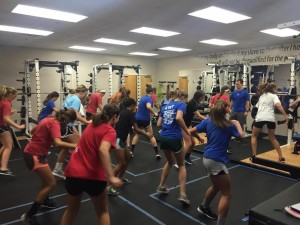 By: Danny Olszowy, CSCS
By: Danny Olszowy, CSCS
The Master’s Academy Strength & Conditioning Coach
Sports Performance Specialist
SPECTRUM, Inc
 In a high school setting often times you will have to work with at least two different teams in the weight room at the same time. Depending on the teams you may have that will force you to be highly creative in your program design to optimize their gains and usage of time. The specific scenario we’re going to discuss is working with both a full soccer and baseball team simultaneously (off-season). The athletes from each sport obviously have differing needs, but how do we address them while they’re training at the same time? I will leave you with a couple nuggets and a sample workout on an effective method of doing so.
In a high school setting often times you will have to work with at least two different teams in the weight room at the same time. Depending on the teams you may have that will force you to be highly creative in your program design to optimize their gains and usage of time. The specific scenario we’re going to discuss is working with both a full soccer and baseball team simultaneously (off-season). The athletes from each sport obviously have differing needs, but how do we address them while they’re training at the same time? I will leave you with a couple nuggets and a sample workout on an effective method of doing so.
Firstly, you have to ask yourself what are the major differences in the sport and consequently their separate needs? That may sound obvious, but common sense does not grow in every ‘flower bed.’ Once you analyze the major differences, you will determine that soccer players tend to have weak glutes and hamstrings, and usually ankle mobility issues. Baseball players always do lots of shoulder work to help strengthen their rotator cuff, but they tend to overdue it and neglect adjacent muscles (such as mid and low trapezius and the backside of the shoulder). We take those aforementioned things into account with our program design. (Remember, we are in small, confined space that will not permit us to running two totally separate workouts because of equipment restrictions and compromise of organization flow.)
Secondly, we have to consider the demands of the sport as a whole and find common ground between the two differing sports and decide on exercises that would benefit both kinds of athletes. Each sport needs power, strength, speed, supreme core strength, unilateral (Single-leg) balance, and the list goes on. So, two almost entirely different sports with one using all lower-half for sport-skills and the other using almost all upper-half with its sports-skill have many common denominators. That means that we focus on those congruent needs first and address the differentiations second.
All of which we have concluded leads us to the point where we write and implement the workout. We just discussed the parallelisms of each sport and their respected needs, so we can agree that we MUST have a power component, strength component, core, and unilateral work in each session. All of the sport-specific needs that differ will then be considered for assistance and/or secondary work. A workout should look something like this:
Baseball WorkoutPower Block
Hang Clean 5@50% 4@60% 4@70% 2×3@80%
Single-Leg Hop 3×3 each leg
Strength Block
Bench Press 6@50% 5@60% 5@70% 2×4@80%
Assistance Block
Letter Holds (YTUW) 3×8 each
Horizontal Pull-up 3×10
Single-Arm DB Bench 3×10 each
Lateral Pillar 3x:30 each
[/one_half]
Soccer WorkoutStrength Block
Bench Press 6@50% 5@60% 5@70% 2×4@80%
Power Block
Hang Clean 5@50% 4@60% 4@70% 2×3@80%
Single-Leg Hop 3×3 each leg
Assistance Block
Single-Leg Squat 3×10 each leg
Alt. DB Bench Press 3×10 each arm
Falling Hamstring (Nordic Curl) 3×6
Lateral Pillar 3x:30 each
[/one_half_last]
As you can see with the first two sections of the workout are the same, just switched so one team can work on the open floor space (Hang Cleans) and the other can work at the racks/platforms (Bench). All of the assistance work is more sport-specific and addressing some of the asymmetries the sport creates. The first two exercises for baseball are mid-back retraction and stabilizing exercises that help keep the shoulder blade in the correct, safe position. The other two are unilateral and core work. For soccer we have the first exercise (SL Squat) that works on recruiting the glute to stabilize us in various athletic movements and indirectly assists in single-leg balance and ankle mobility. The second exercise is unilateral; third loads the hamstrings eccentrically (which helps prevent hamstring strains/pulls); lastly, a core exercise that helps strengthen the intra-abdominal (muscles wrapped around spine) muscles to avoid any core-related injuries.
In our setting of working with high school athletes we always have to ask ourselves what is it I am trying to get out of this exercise/movement and whom am I doing it for? Many high schools have advanced athletes in the same team/group as beginners, so we have to do our job of still getting the most out of both of those kinds of athletes. The bits of information I shared with you should help you with the process of dealing with different teams that have different needs at the same time in the weight room.
Leave a Reply